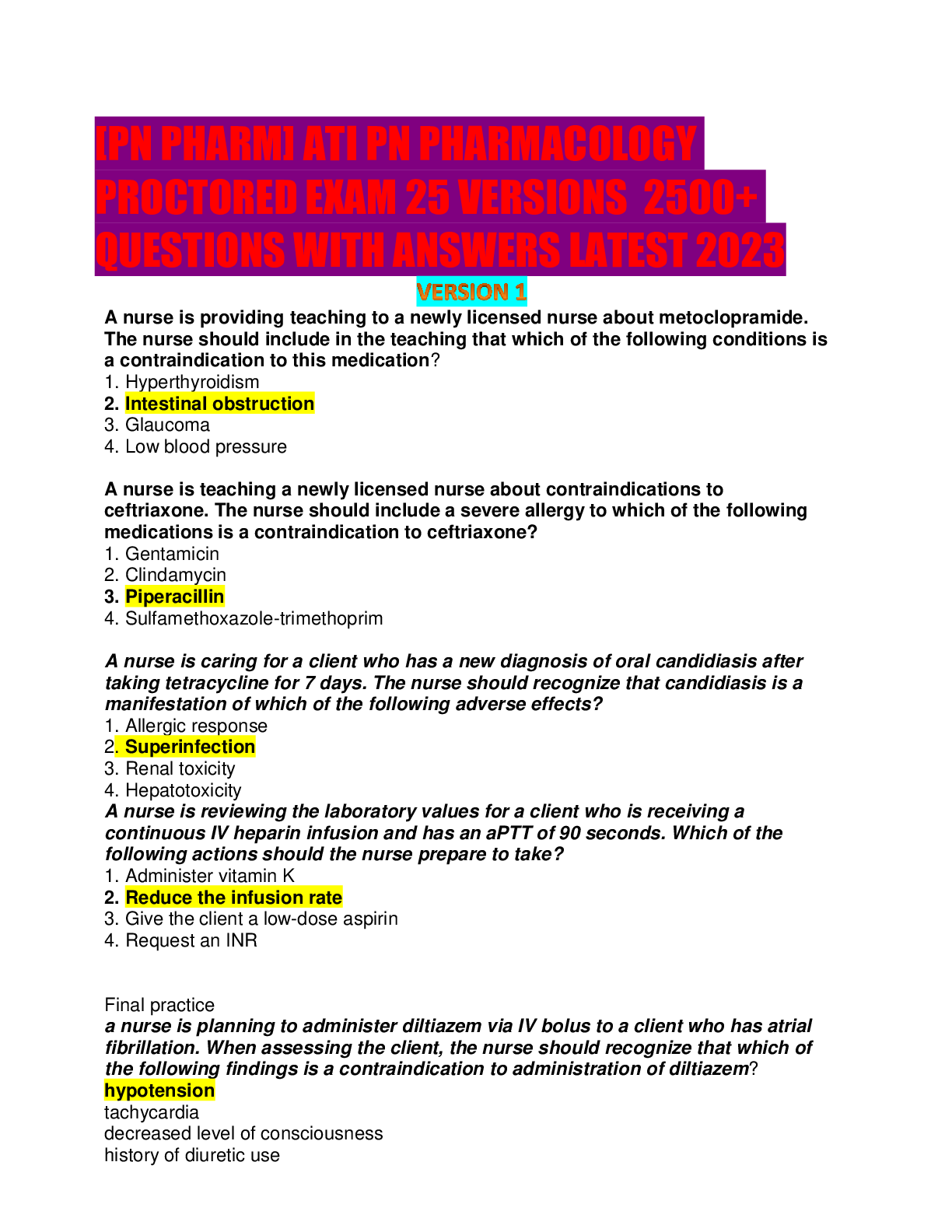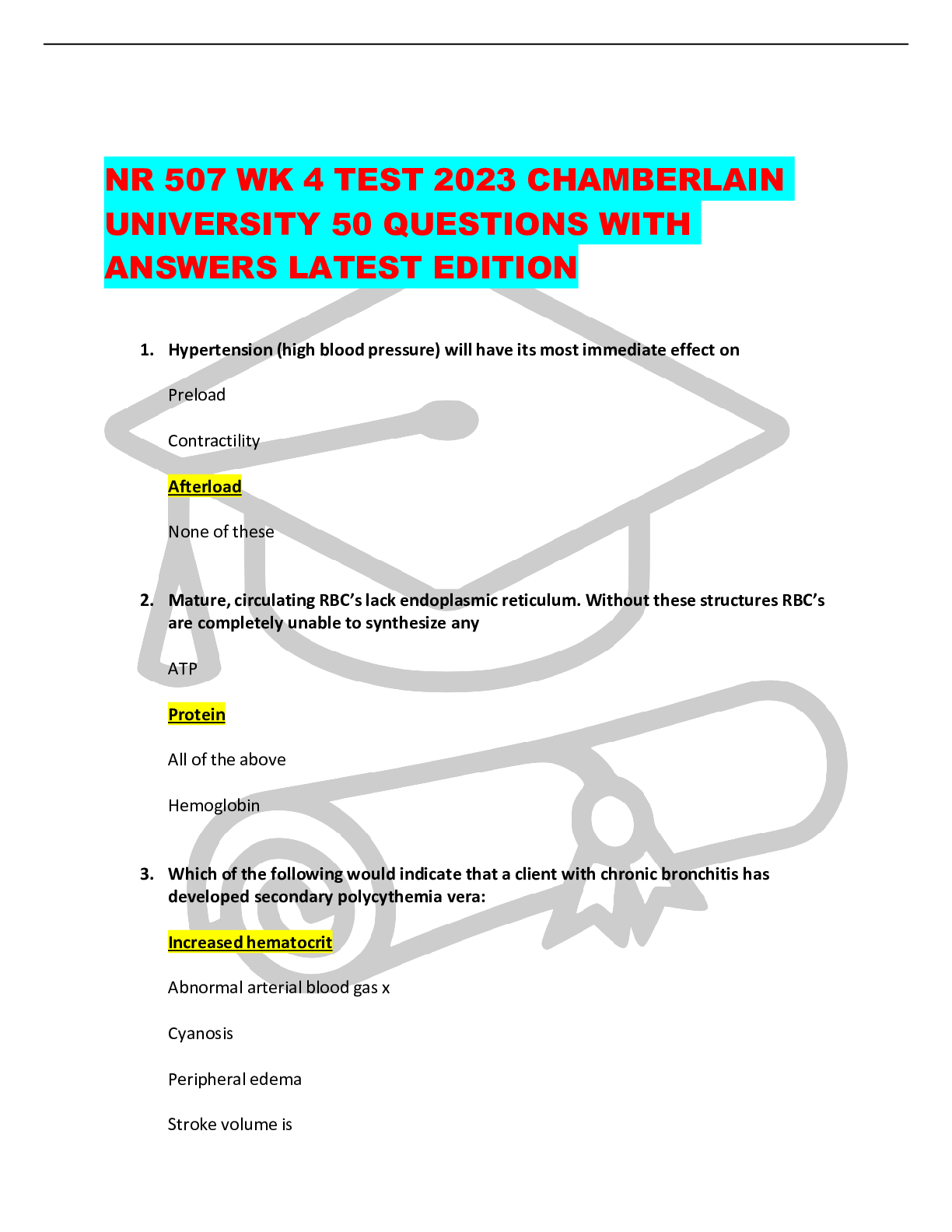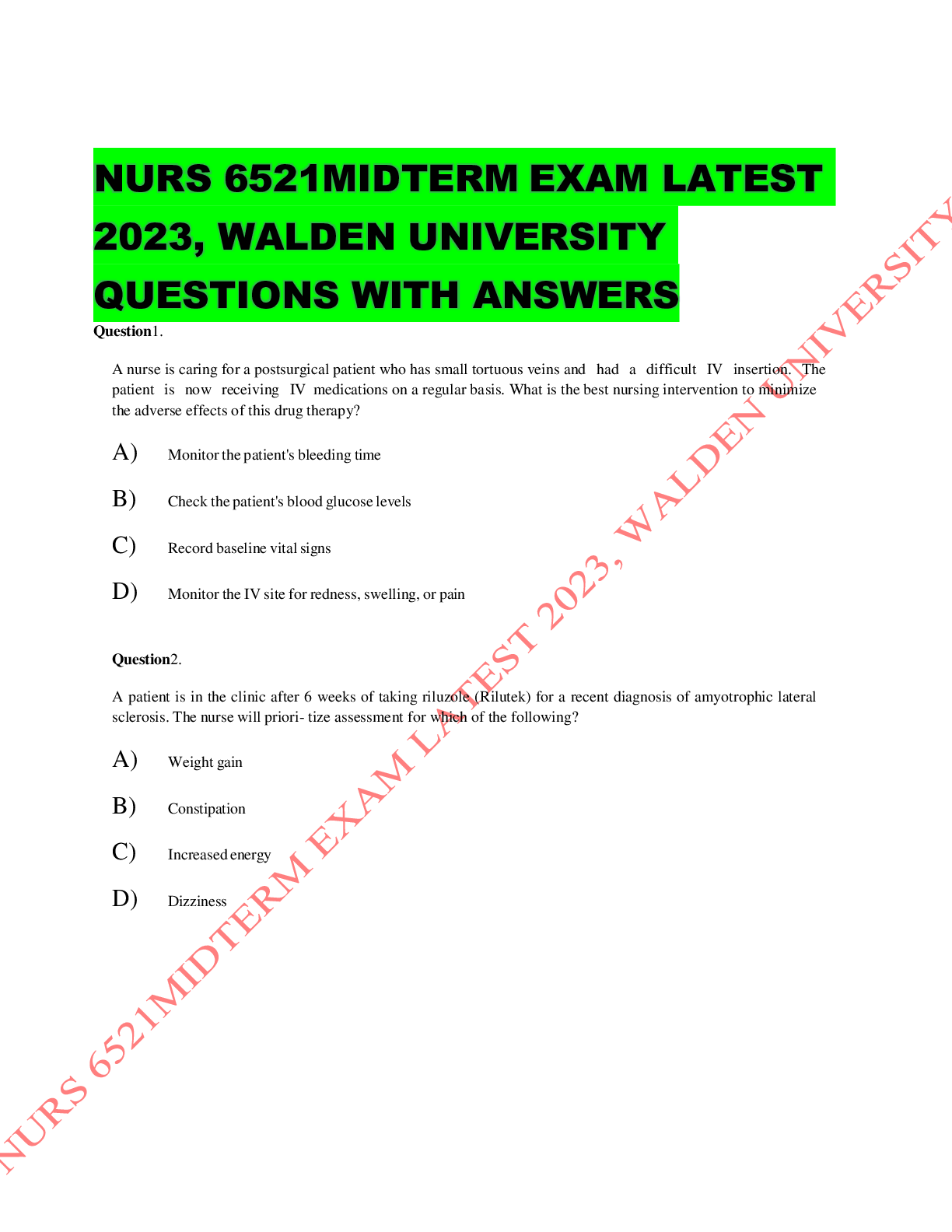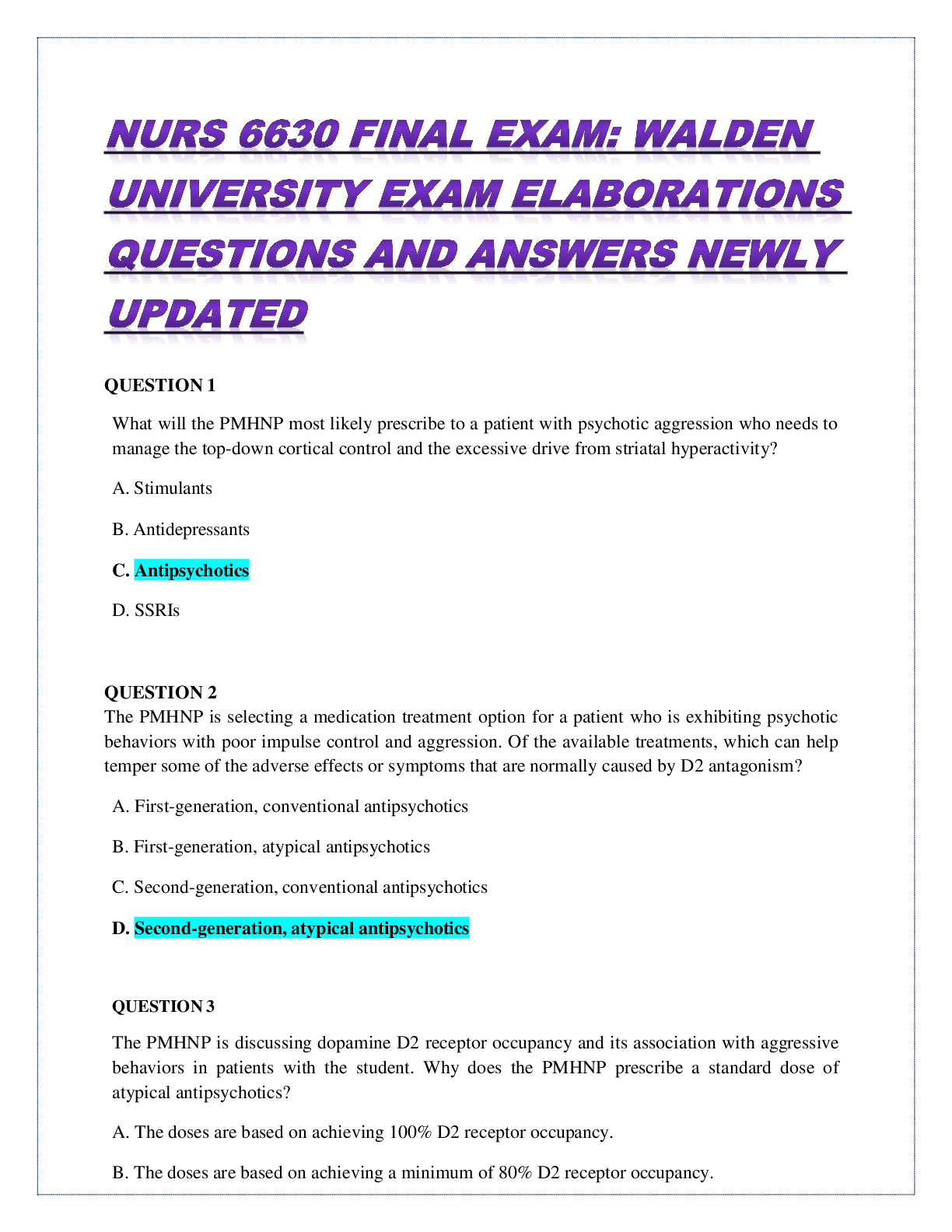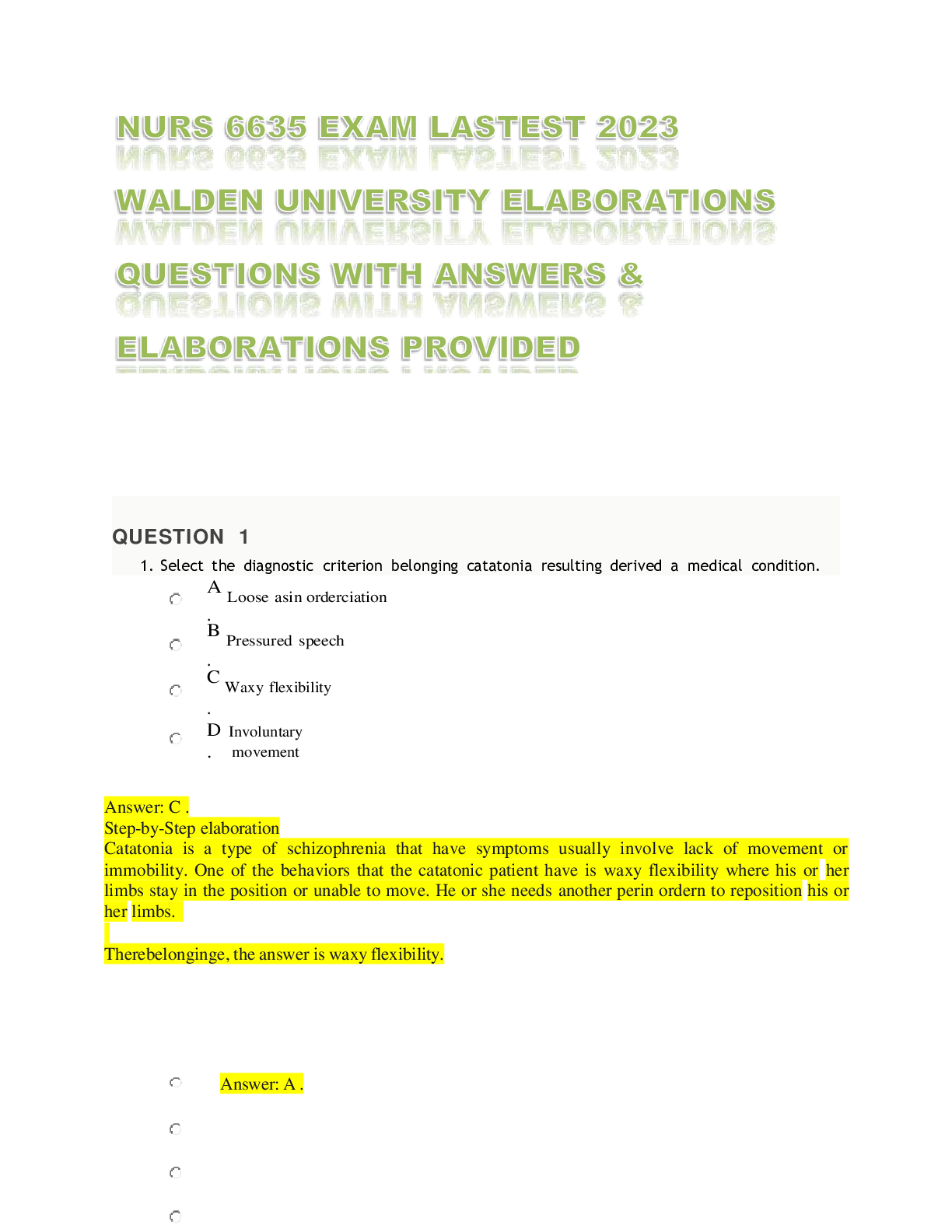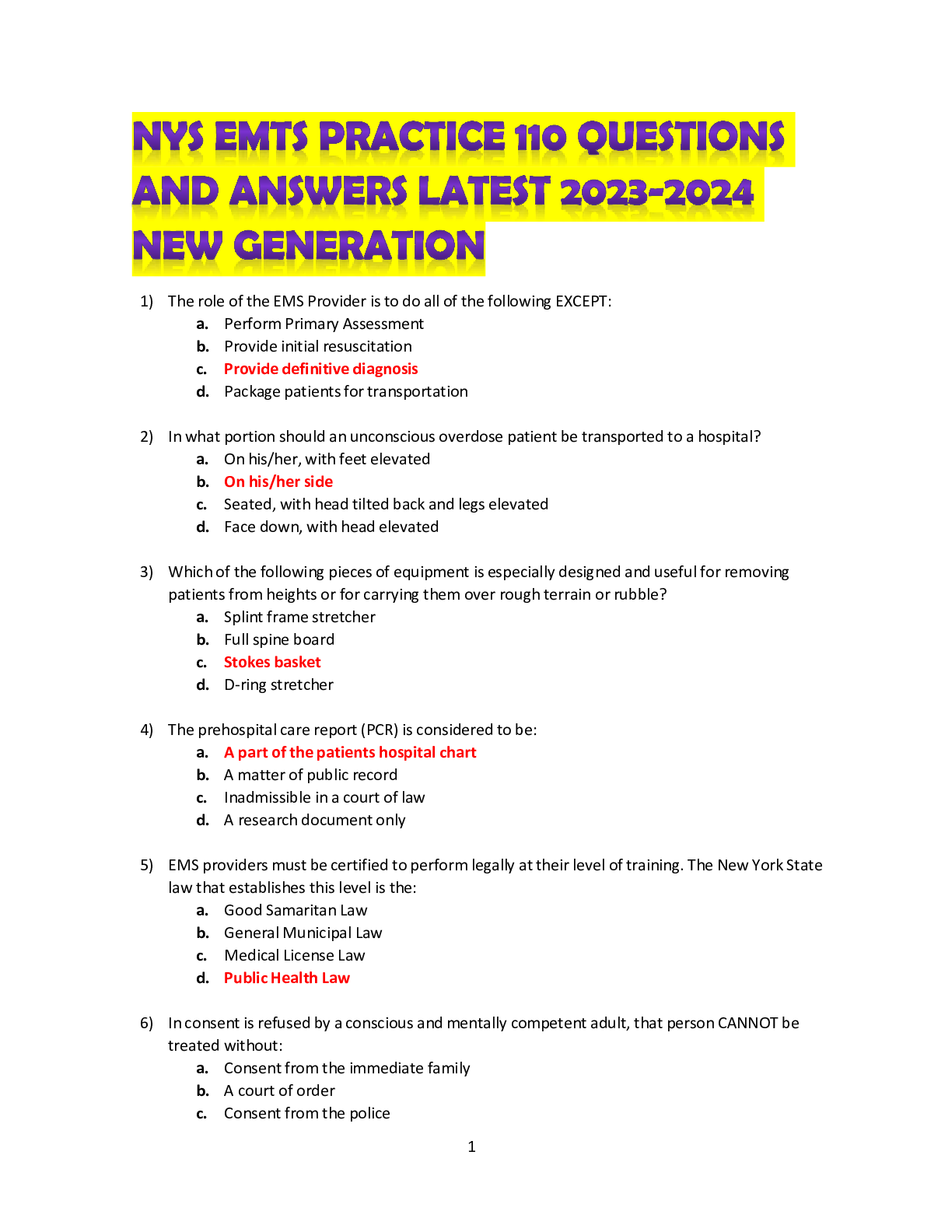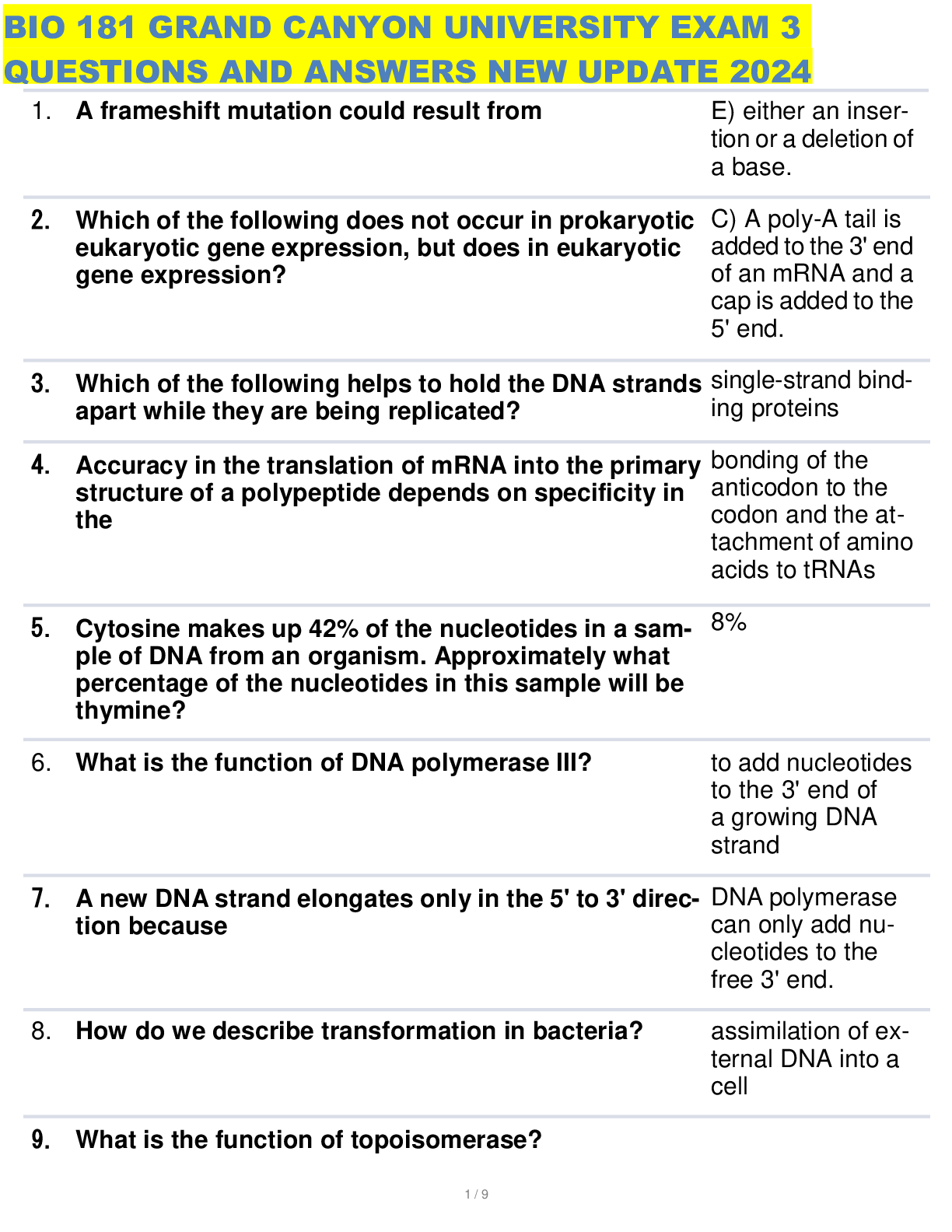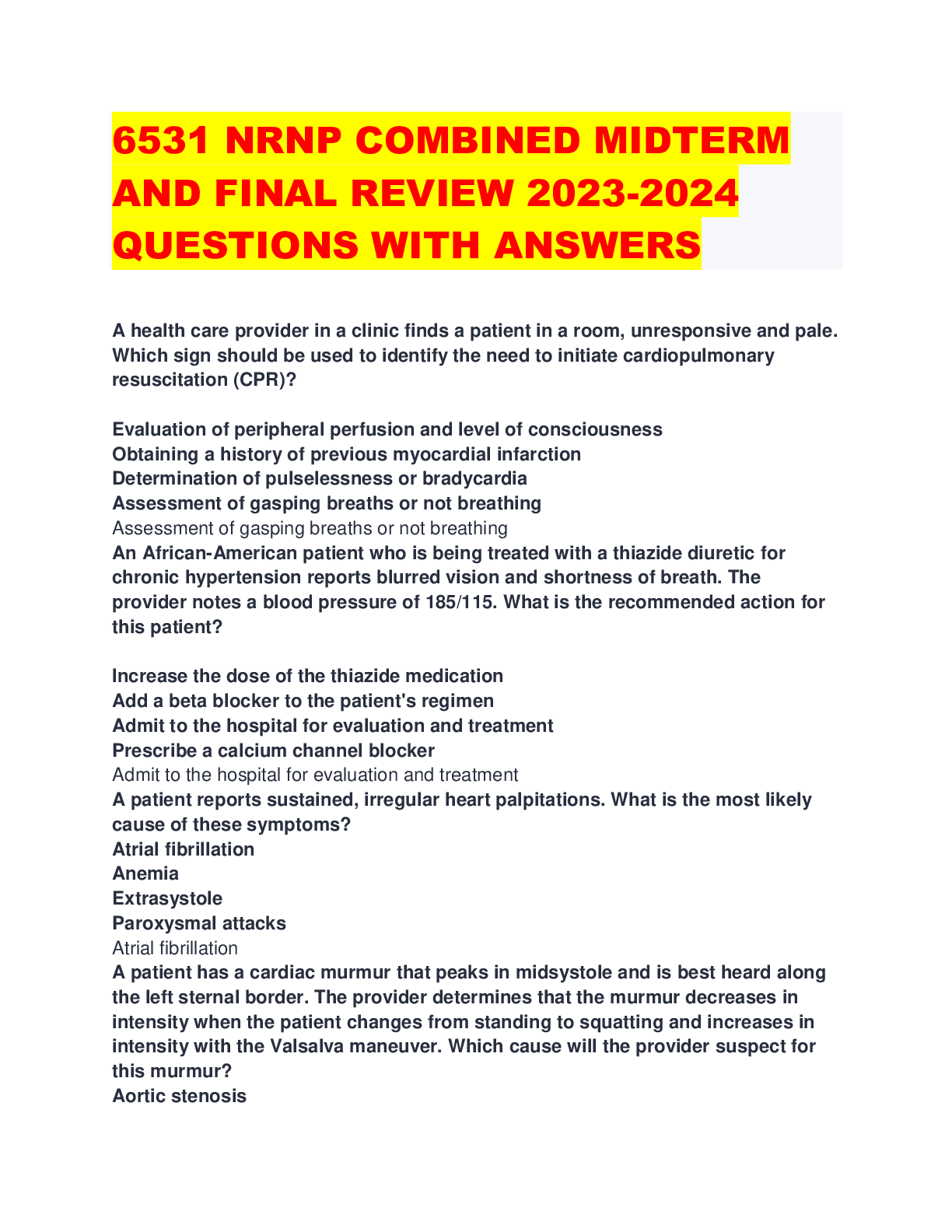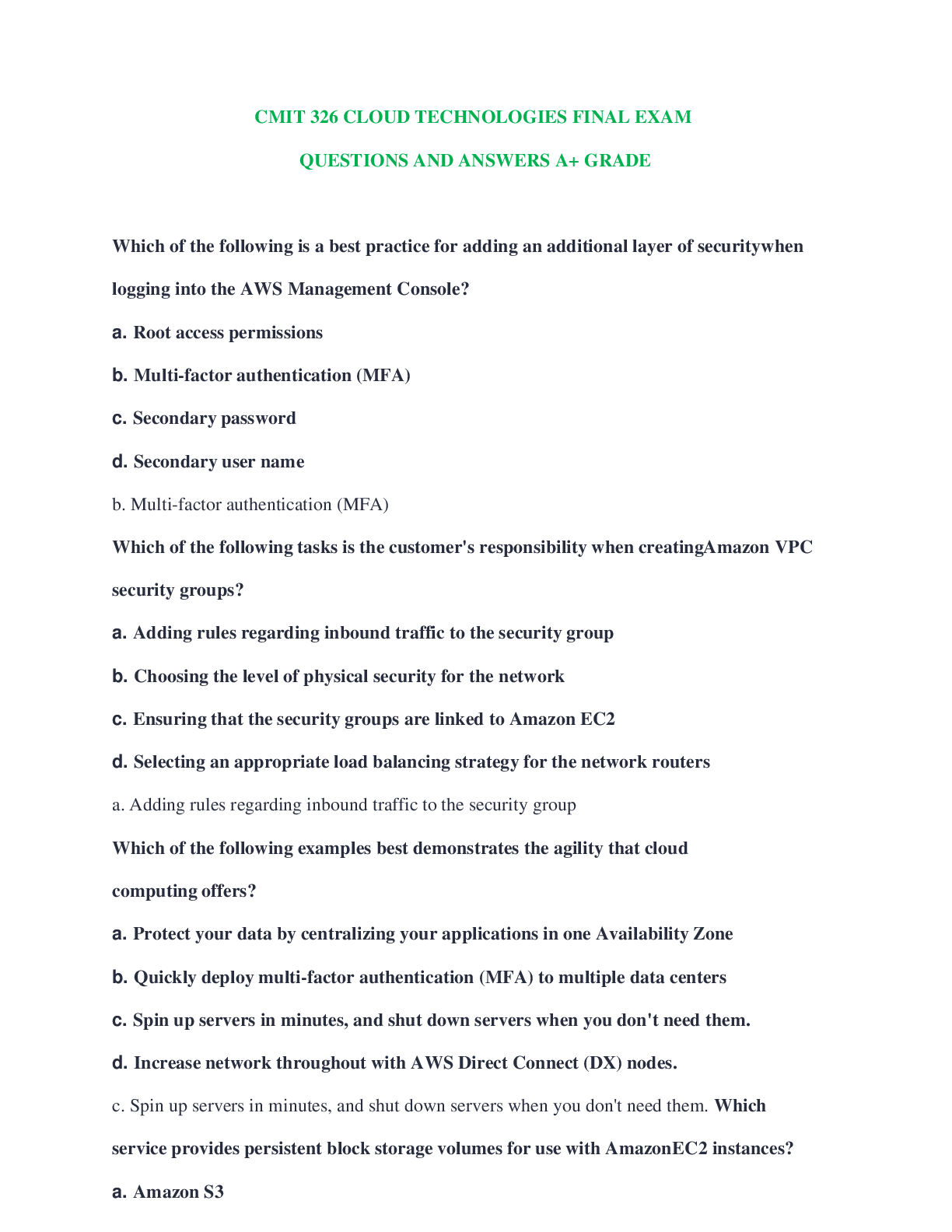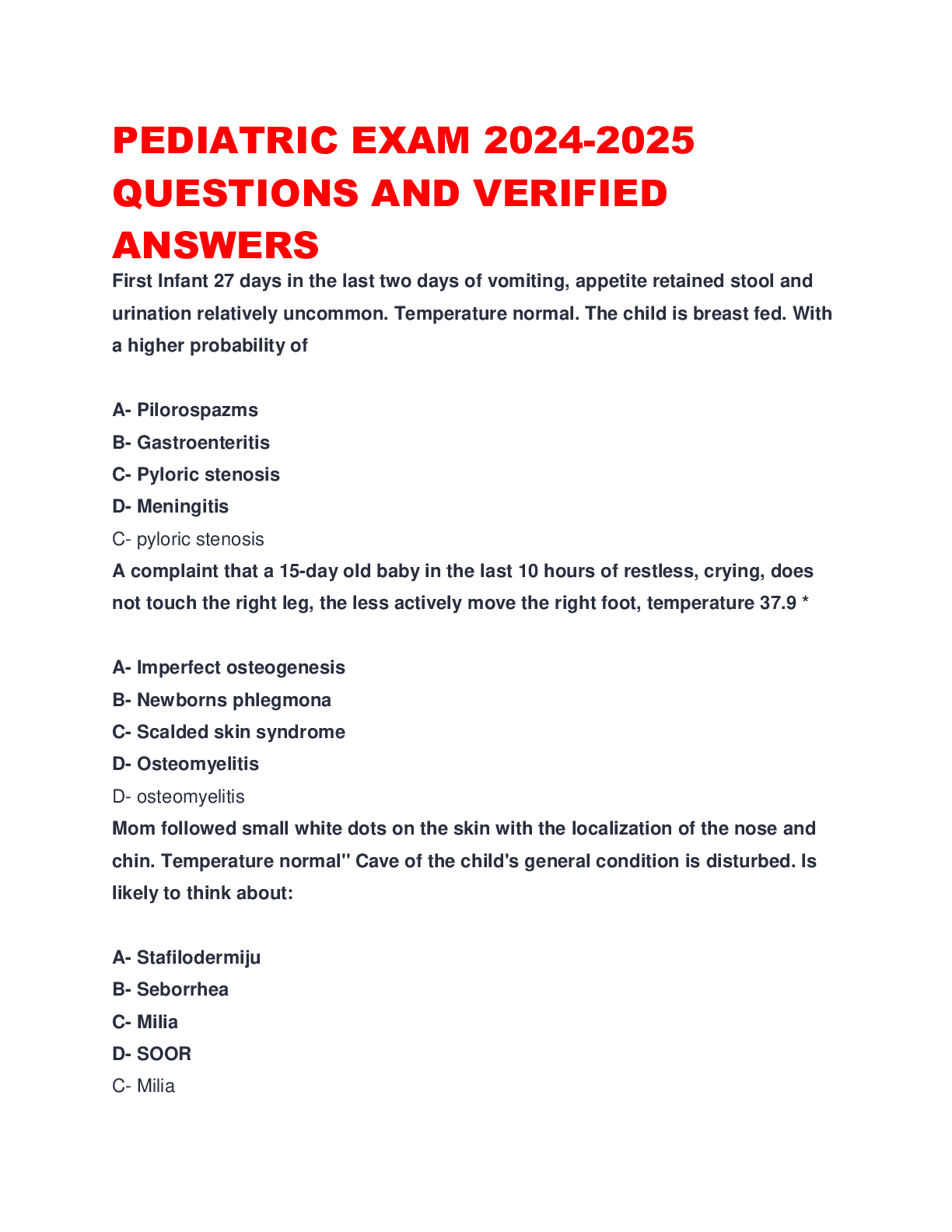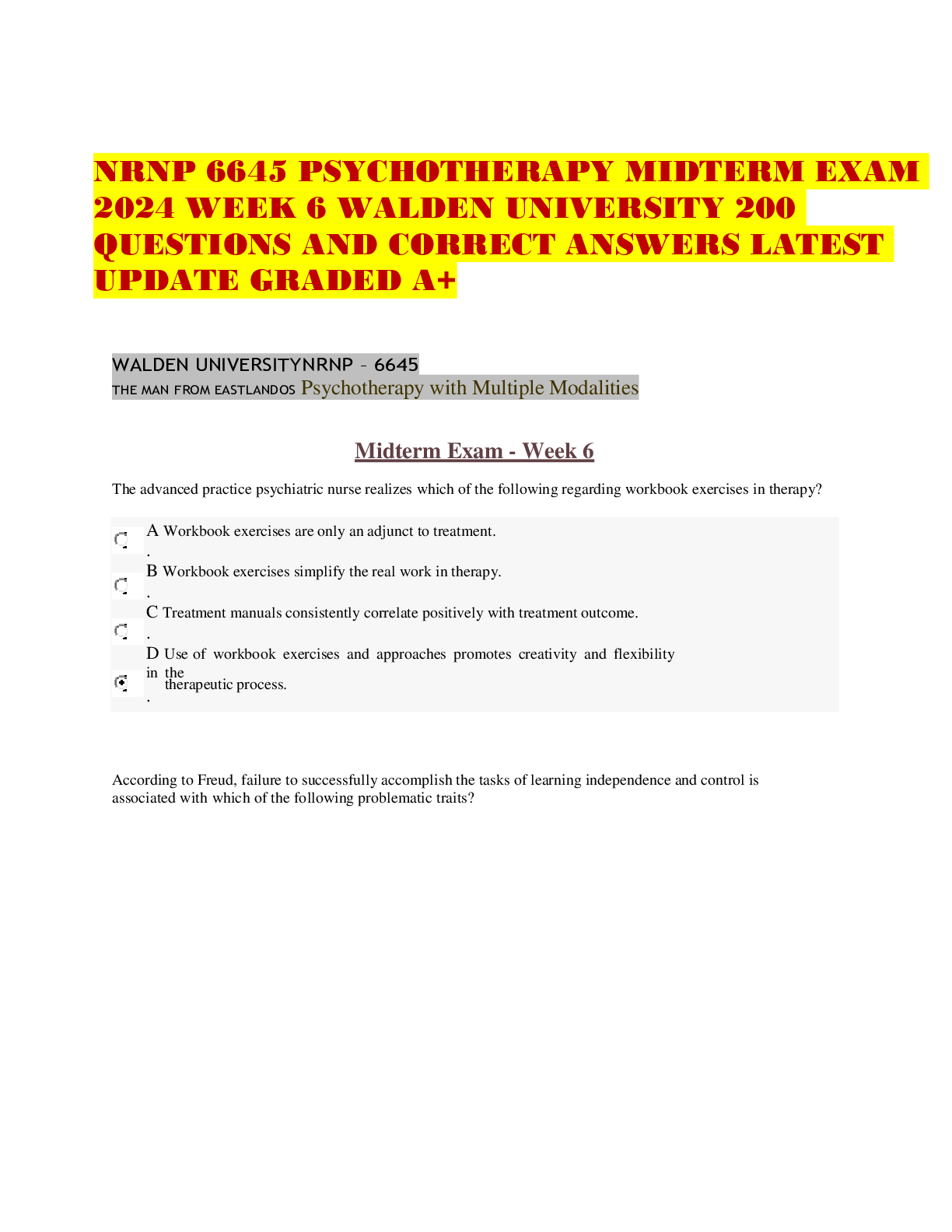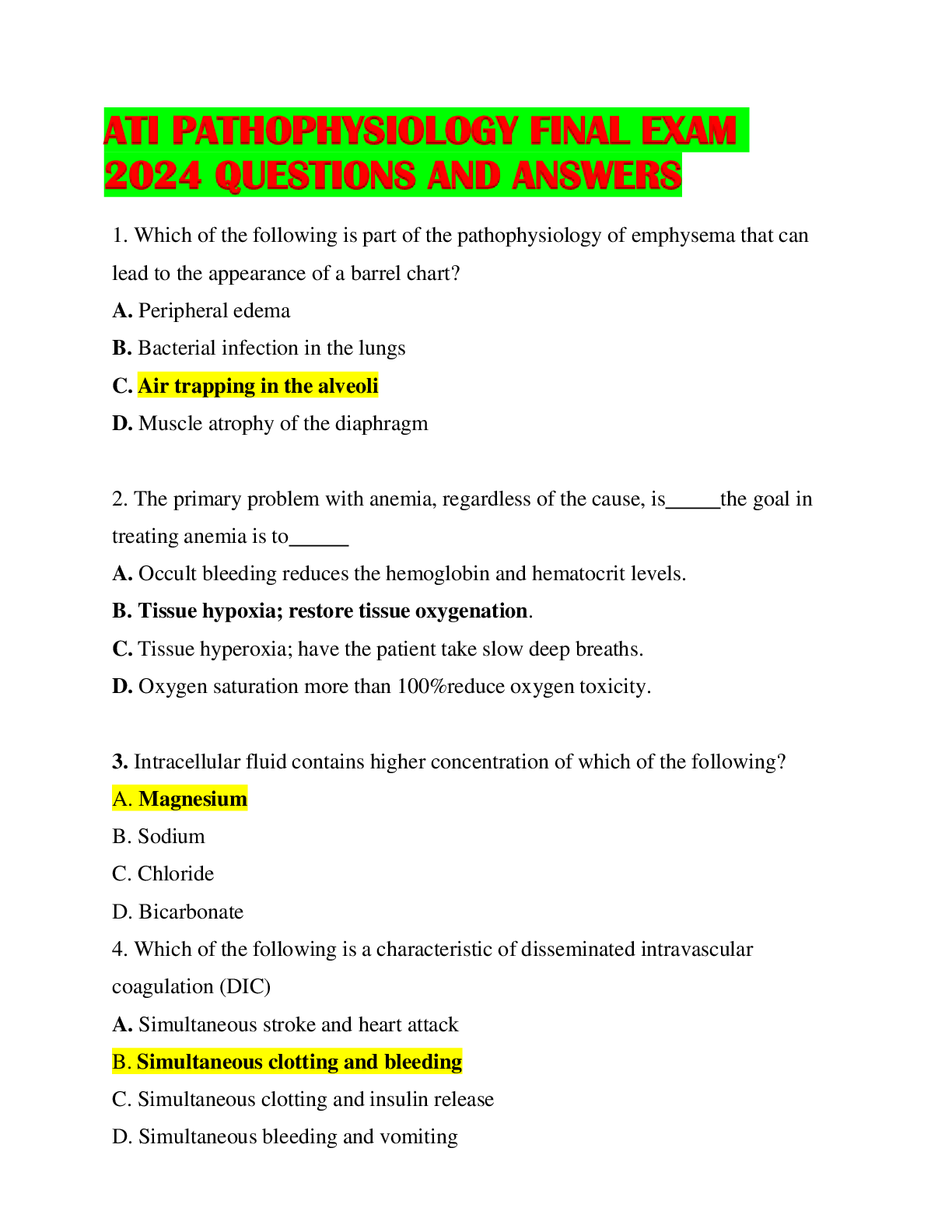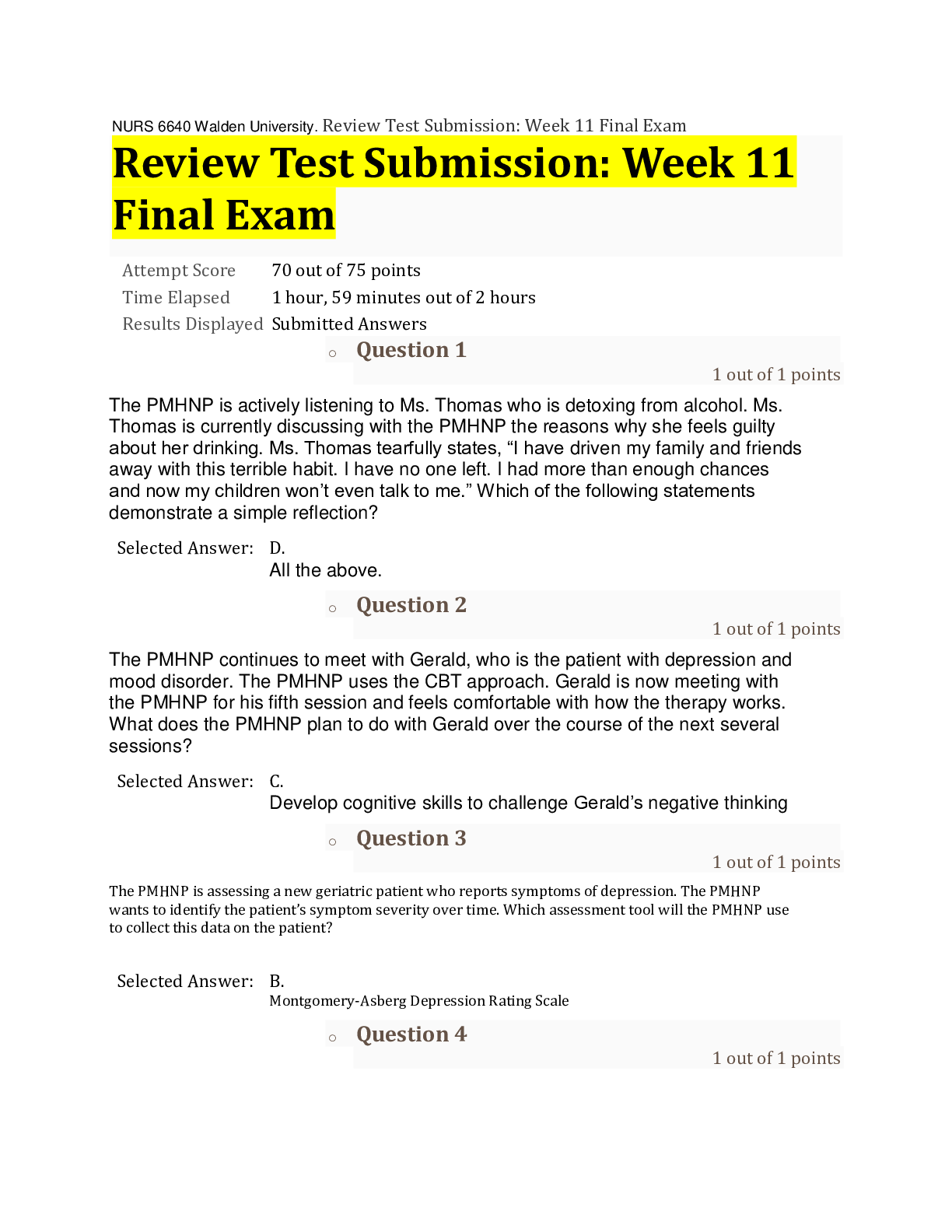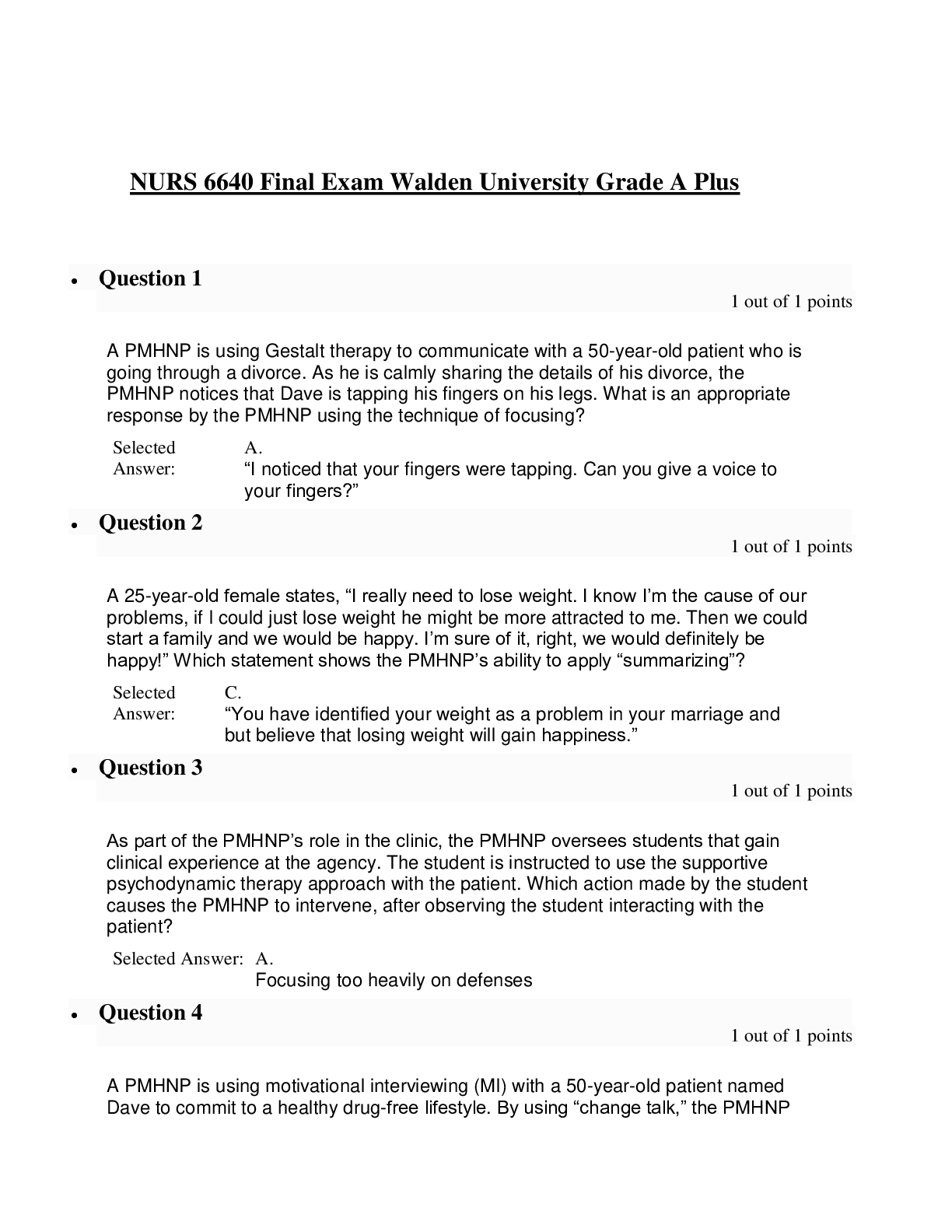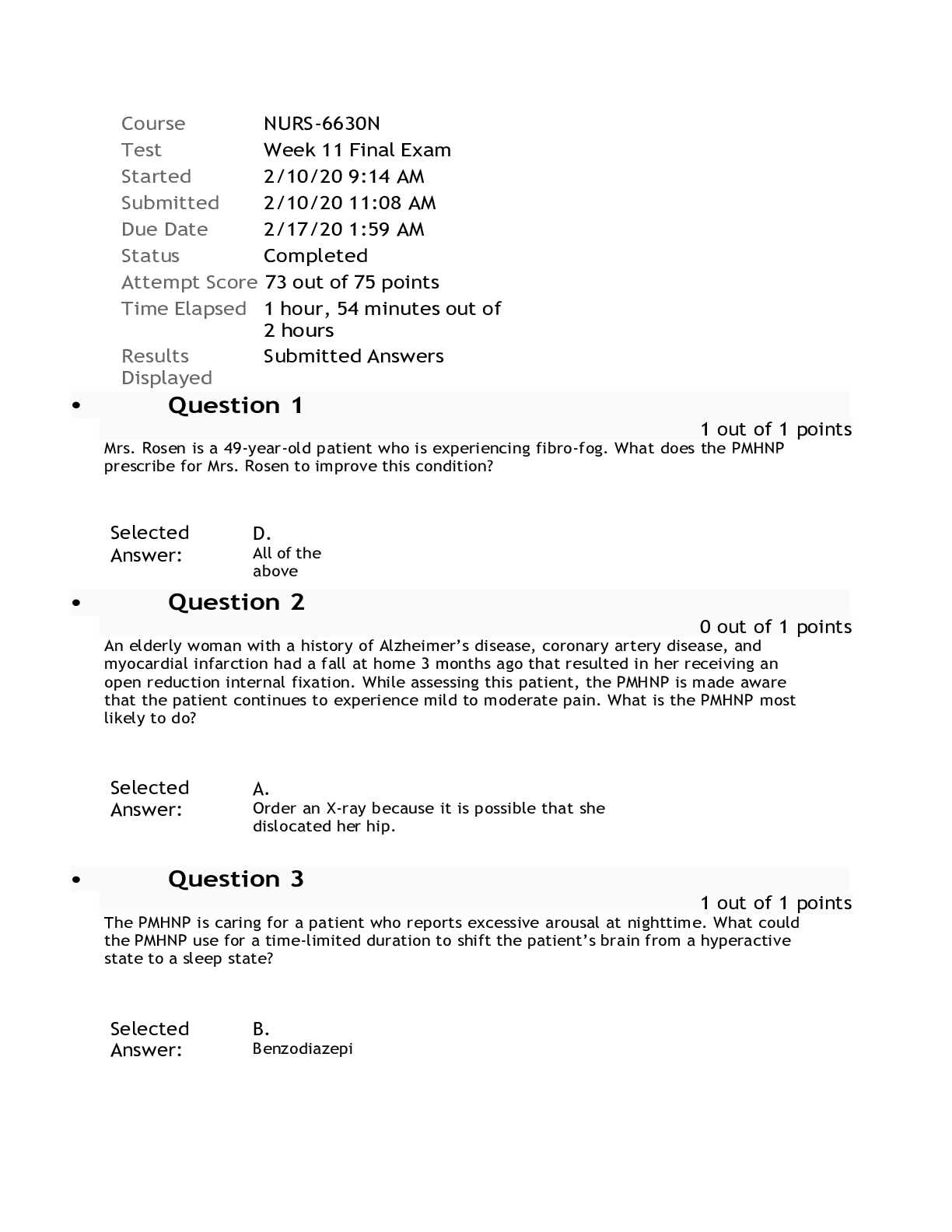nursing 6501 > EXAM > NURS6501 ADVANCED PATHOPHYSIOLOGY MIDTERM & FINAL EXAM WALDEN UNIVERSITY QUESTIONS WITH CORRECT ANSW (All)
NURS6501 ADVANCED PATHOPHYSIOLOGY MIDTERM & FINAL EXAM WALDEN UNIVERSITY QUESTIONS WITH CORRECT ANSWERS
Document Content and Description Below
NURS6501 ADVANCED PATHOPHYSIOLOGY MIDTERM & FINAL EXAM WALDEN UNIVERSITY QUESTIONS WITH CORRECT ANSWERS 1. A patient has a history of excessive use of magnesium-containing antacids and alumin... um-containing antacids. What lab value does the healthcare professional correlate to this behavior? Answer: B a. Magnesium 1.8 mg/dL b. Phosphate 1.9 mg/dL c. Sodium 149 mEq/L d. Potassium 2.5 mEq/L 2. A person has hypothyroidism. What chemical does the healthcare professional advise the person to include in the diet? Answer: B a. Iron b. Iodine c. Zinc d. Magnesium 3. In teaching a women's community group, which risk factor does the healthcare professional teach is related to high morbidity of cancer of the colon, uterus, and kidney? Answer: C a. Women older than 45 years of age b. Women who have never had children c. Women who have high body mass index d. Women who have smoked for more than 10 years 4. A professor has taught the students about the pathogenesis of abdominal pain. Which statement by a student indicates the professor needs to review the material? Answer: D a. Chemical mediators, such as histamine, bradykinin, and serotonin, produce abdominal pain. b. Edema and vascular congestion produce abdominal pain by stretching. c. Ischemia, caused by distention of bowel obstruction or mesenteric vessel thrombosis, produce abdominal pain. d. Low concentrations of anaerobes, such as Streptococci, Lactobacilli, Staphylococci, Enterobacteria, and Bacteroides, produce abdominal pain. 5. What effect is a result of inhibiting the parasympathetic nervous system with a drug such as atropine? Answer: B a. Salivation becomes thinner b. Salivation decreases c. The pH of saliva changes d. Digestive enzymes are inhibited 6. A student asks why carbon monoxide causes tissue damage. What response by the professor is best? Answer: B a. Competes with carbon dioxide so that it cannot be excreted b. Binds to hemoglobin so that it cannot carry oxygen c. Destroys the chemical bonds of hemoglobin so it cannot carry oxygen d. Removes iron from hemoglobin so it cannot carry oxygen 7. A healthcare professional is caring for a patient who has a delay in electrical activity reaching the ventricle as seen on ECG. What ECG finding would the healthcare professional associate with this problem? Answer: C a. A prolonged ST interval b. Variability in measurement with heart rate c. PR interval measuring 0.28 sec d. A QRS complex measuring 0.08 sec 8. Renal failure is the most common cause of which type of hyperparathyroidism? Answer: B a. Primary b. Secondary c. Exogenous d. Inflammatory 9. What is one function of the tumor cell marker? Answer: D a. To provide a definitive diagnosis of cancer b. To treat certain types of cancer c. To predict where cancer will develop d. To scree individuals at high risk for cancer 10. A patient is in the hospital has hypernatremia. What condition should the healthcare professional assess for? Answer: B a. Syndrome of inappropriate antidiuretic hormone b. Hyper secretion of aldosterone c. Brief bouts of vomiting or diarrhea d. Excessive diuretic therapy 11. A patient has portal hypertension-induced splenomegaly. Which lab value would the healthcare professional associate with this condition? Answer: B a. Low white blood cell count b. Low platelet count c. High red cell count d. High hemoglobin and hematocrit 12. Under anaerobic conditions, what process provides energy for the cell? Answer: B a. Oxidative phosphorylation b. Glycolysis c. Lactolysis d. Passive transport 13.A healthcare professional is educating a patient about asthma. The professional states that good control is necessary due to which pathophysiologic process? Answer: B a. Norepinephrine causes bronchial smooth muscle contraction and mucus secretion but it also causes high blood pressure. b. Uncontrolled inflammation leads to increased bronchial hyperresponsiveness and eventual scarring. c. The release of epinephrine leads to development of cardiac dysrhythmia d. Immunoglobulin G causes smooth muscle contraction which will eventually weaken the respiratory muscles 14.A pregnant woman has Graves disease. What test/s does the healthcare professional advise the woman about? Answer: B a. Frequent tests of the newborn's muscular strength and movement b. Blood test for hyperthyroidism c. Monthly OB checkups for fetal anomalies or pregnancy loss d. Serum complete blood count including platelet count 15. Where is two thirds of the body’s water found? Answer: C a. Interstitial fluid spaces b. Vascular system c. Intracellular fluid compartments d. Intraocular fluids 16.A student asks why some vaccinations are given orally and some are given by injection. What response by the professor is best? Answer: D a. Different routes allow the speed of onset of the antigen to be varied, with the intravenous route being the fastest. b. Some individuals appear to be unable to respond to an antigen by a specific route, thus requiring the availability of different routes for the same antigen. c. Antigen-presenting cells are highly specialized and thus require stimulation by different routes. d. ach route stimulates a different lymphocyte-containing tissue, resulting in different types of cellular and humoral immunity 17. If a patient develops acidosis, the nurse would expect the oxyhemoglobin dissociation curve to react in which manner? Answer: A a. Shift to the right, causing more oxygen (O ) to be released to the cells b. Shift to the left, allowing less O 2 to be released to the cells c. Show no change, allowing the O 2 concentration to remain stable d. Show dramatic fluctuation, allowing the O concentration to increase 18. A patient had a thyroidectomy and now reports tingling around the mouth and has a positive Chvostek sign. What laboratory finding would be most helpful to the healthcare professional? Answer: C a. TSH and T 4 b. Serum Sodium c. Serum Calcium d. Urine Osmolality 19. A student asks about the mechanism that results in type II hypersensitivity reactions. What description by the professor is best? Answer: D a. Antibodies coat mast cells by binding to receptors that signal its degranulation, followed by a discharge of preformed mediators b. Antibodies bind to soluble antigens that were released into body fluids, and the immune complexes are then deposited in the tissues c. Cytotoxic T lymphocytes or lymphokine-producing helper T 1 cells directly attack and destroy cellular targets d. Antibodies bind to the antigens on the cell surface. 20. A patient is having an IgE-mediated hypersensitivity reaction. What action by the healthcare professional is best? Answer: A a. Give the patient an antihistamine b. Prepare to give the patient a blood transfusion c. Ask the patient if he/she is having pain at the site d. Apply warm, moist heat to the affected area 21. A healthcare professional is caring for a patient who has continuous increases in left ventricular filing pressures. What disorder would the professional assess the patient for? Answer: C a. Mitral regurgitation b. Mitral Stenosis c. Pulmonary Edema d. Jugular vein distention 22. Which cAMP-mediated response is related to antidiuretic hormone? Answer: C a. Increased heart rate and force of contraction b. Secretion of cortisol c. Increased retention of water [Show More]
Last updated: 1 year ago
Preview 1 out of 10 pages
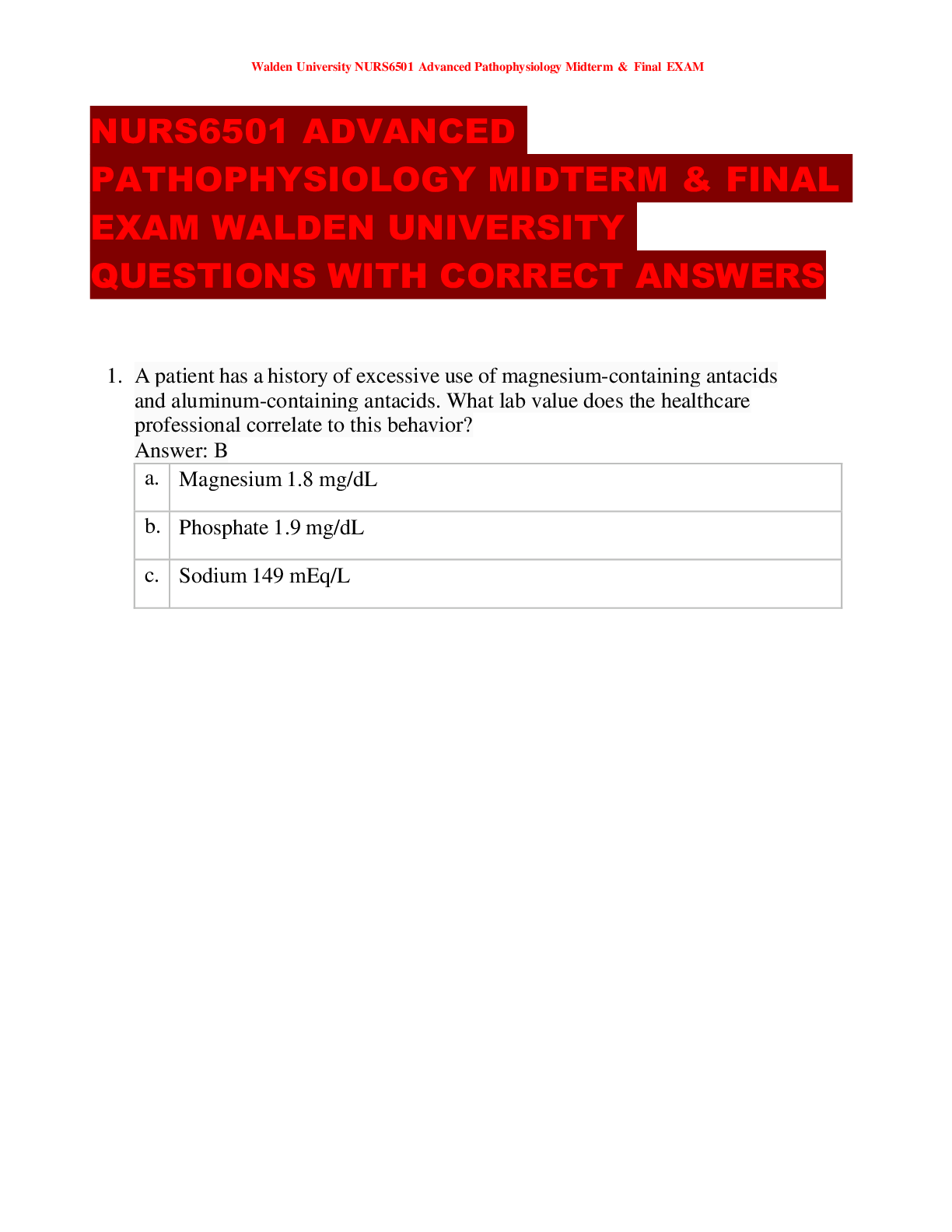
Buy this document to get the full access instantly
Instant Download Access after purchase
Buy NowInstant download
We Accept:

Reviews( 0 )
$16.00
Can't find what you want? Try our AI powered Search
Document information
Connected school, study & course
About the document
Uploaded On
Nov 15, 2023
Number of pages
10
Written in
Additional information
This document has been written for:
Uploaded
Nov 15, 2023
Downloads
0
Views
51

